Embarking on the journey of astronomy as a telescope amateur is akin to setting sail for uncharted territories right from your backyard. As a content creator passionate about discovery, I understand the deep human desire to explore, whether it’s a bustling marketplace in Marrakech or the swirling arms of a distant galaxy. A telescope isn’t just an instrument; it’s a portal to cosmic wonders, a tool that lets us connect with the vastness of the universe from our own quiet corner of the planet.
But for newcomers, the world of telescopes can seem as daunting as deep space itself. Aperture, focal length, mounts, refractors, reflectors – where does a beginner even begin? This guide cuts through the jargon, offering insights and recommendations to help you find the perfect telescope amateur setup to unlock the secrets of the night sky.
Choosing your first telescope as a telescope amateur is a significant step. It should be exciting, not overwhelming. The right scope will depend on what you want to see, where you’ll be observing from, your budget, and how much complexity you’re ready to handle. We’ve tested numerous models, focusing on usability, performance, and value for those just starting out or looking to deepen their new hobby. Here are some top picks that stand out for the amateur astronomer.
Navigating the Cosmos: Top Telescope Amateur Picks
The world of telescopes offers a range of options, each suited to different needs and interests for the budding [amatuer telescope enthusiast. From simple, grab-and-go models to more advanced, computerized systems, there’s a scope designed to help you find your way among the stars.
Celestron NexStar 4SE: A Solid Start for the Telescope Amateur
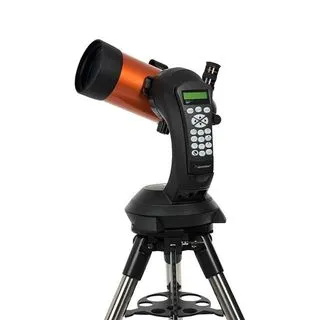
Celestron NexStar 4SE telescope on a white background
What to Eat in Fort Worth – A Culinary Deep Dive
Discover the Top Restaurants in Denver – A Culinary Journey
Discover Where to Visit in Las Vegas
When you’re just starting out, ease of use is paramount. The Celestron NexStar 4SE is consistently recommended as a fantastic [hobby telescope](https://lifetodiscover.com/hobby-telescope/) for beginners. Its standout feature is the fully computerized GoTo mount with SkyAlign technology, which simplifies finding celestial objects immensely. Instead of needing extensive knowledge of constellations, you just need to align it with a few bright stars, and the telescope does the rest, automatically locating and tracking thousands of objects. This is a game-changer for the [amateur astronomy telescope](https://lifetodiscover.com/amateur-astronomy-telescope/) newcomer who might otherwise get frustrated trying to manually locate faint targets.
Specs like its 4-inch (102mm) aperture and 1325mm focal length mean you’ll get clear, bright views, particularly of the Moon and planets. While its narrow field of view isn’t ideal for large deep-sky objects, it excels at bringing the details of our solar system up close. It’s sturdy and well-built, offering a reliable platform for observation, making it a trustworthy option often appearing in lists of the [top 10 amatuer telescopes]. However, its weight and a tripod that doesn’t fold down completely limit its portability, making it better suited for backyard stargazing – a perfect [good backyard telescope]. Also, be prepared for it to consume batteries quickly, so an external power source is highly recommended.
- Optical design: Maksutov-Cassegrain
- Mount type: Computerized Alt-Azimuth
- Aperture: 4-inches / 102mm
- Focal length: 1325mm
- Highest useful magnification: 241x
- Lowest useful magnification: 15x
- Supplied eyepieces: 25mm
- Weight: 23 lbs (10.44kg) fully assembled
Celestron Inspire 100AZ Refractor: Budget-Friendly Exploration
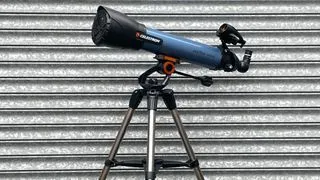 The Celestron Inspire 100AZ telescope set up outdoors
The Celestron Inspire 100AZ telescope set up outdoors
For the cost-conscious telescope amateur, the Celestron Inspire 100AZ Refractor offers a very accessible entry point. It’s a simple, straightforward telescope that is quick to set up and start observing. The 100mm aperture provides decent light gathering for a budget scope, allowing for enjoyable views of the Moon and brighter planets. It sits on a basic altazimuth mount, which requires manual tracking, meaning you’ll need to learn how to navigate the sky yourself, perhaps with the help of a star chart or app. This hands-on approach can be very rewarding for the [amatuer telescope](https://lifetodiscover.com/amatuer-telescope/) who enjoys the process of discovery.
A neat feature for the modern amateur is the lens cap that doubles as a smartphone adapter, allowing you to easily try your hand at basic astrophotography. While it performs well for lunar and planetary viewing, deep-sky objects might appear less detailed. Some chromatic aberration (color fringing) can be noticeable on bright objects, but this is common in budget refractors and generally doesn’t detract significantly from the overall experience for a beginner. Its lightweight frame makes it reasonably portable for short trips or moving around the backyard.
- Optical design: Refractor
- Mount type: Alt-azimuth
- Aperture: 3.94-inches / 100mm
- Focal length: 660mm
- Highest useful magnification: 241x
- Lowest useful magnification: 15x
- Supplied eyepieces: 10mm, 25mm
- Weight: 20 lbs (9.07kg)
Celestron Astro Fi 130: Value for the Enthusiast
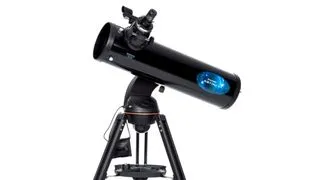 The Celestron Astro Fi 130 on a tripod on a white background
The Celestron Astro Fi 130 on a tripod on a white background
Bridging the gap between beginner and more serious enthusiast, the Celestron Astro Fi 130 offers excellent value, combining a capable Newtonian reflector with computerized GoTo functionality controlled via a smartphone app. For the telescope amateur who loves gadgets and wants the convenience of automated object finding without a premium price tag, this is a strong contender. The 130mm aperture provides ample light-gathering ability, allowing for good views of planets, the Moon, and even some brighter deep-sky objects like the Andromeda Galaxy.
Control is entirely through the Celestron SkyPortal app, which is intuitive and even suggests interesting objects to view based on your location and time. This digital integration makes the learning curve for target acquisition much smoother for the amateur astronomy telescopehobbyist. It’s relatively portable and features a sturdy tripod. While the included eyepieces are basic, upgrading them can significantly enhance the views. The main drawbacks are the reliance on the app (it’s useless without it) and the battery drain, particularly in cold weather. However, for its price point, the combination of aperture and GoTo technology makes it a very attractive option for the developing amateur astronomer.
- Optical design: Newtonian Reflector
- Mount type: Computerized altitude-azimuth single fork
- Aperture: 5.19-inches / 130mm
- Focal length: 650mm
- Highest useful magnification: 307x
- Lowest useful magnification: 19x
- Supplied eyepieces: 25mm and 10mm
- Weight: 18 lbs (8.6kg)
Celestron NexStar Evolution 9.25: Premium Experience
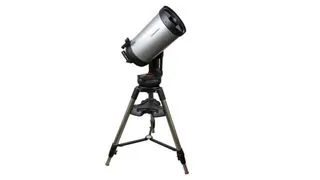 The Celestron NexStar Evolution 9.25 on a tripod on a white background
The Celestron NexStar Evolution 9.25 on a tripod on a white background
If you’re a telescope amateur ready to make a significant investment for breathtaking views, the Celestron NexStar Evolution 9.25 is a top-tier option. This Schmidt-Cassegrain telescope boasts a large 9.25-inch (235mm) aperture, gathering a huge amount of light for incredibly detailed and crisp views of planets, the Moon, nebulas, and galaxies. Its motorized alt-azimuth fork arm mount is incredibly stable and features a built-in rechargeable lithium-ion battery providing hours of use.
Setup is surprisingly easy for such a capable scope, and like other NexStar models, it features reliable GoTo technology controlled via a hand control or the SkyPortal app. The optical quality is exceptional, delivering sharp images across the entire field of view. While its size and weight make it less portable – definitely a [good backyard telescope] rather than a travel companion – its performance for visual observation and suitability for astrophotography (thanks to accurate tracking) justify its premium price. This is a scope designed to grow with the amatuer telescope who is serious about their hobby and expects stunning results.
- Optical design: Schmidt-Cassegrain
- Mount type: Computerized alt-azimuth fork arm
- Aperture: 9.25-inches / 235mm
- Focal length: 2350mm
- Highest useful magnification: 555x
- Lowest useful magnification: 34x
- Supplied eyepieces: 13mm, 40mm
- Weight: 62.60 lbs (28.39kg)
Celestron FirstScope 76 Tabletop: A Kid’s First Glimpse
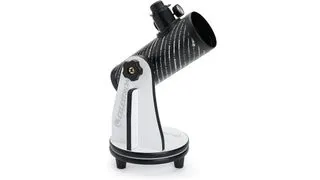 Celestron FirstScope on a white background
Celestron FirstScope on a white background
Introducing the next generation to the wonders of the night sky is a truly rewarding experience. The Celestron FirstScope 76 Tabletop telescope is an ideal hobby telescope for young aspiring astronomers or casual observers. It arrives fully assembled, making it incredibly easy to use right out of the box – perfect for impatient kids. Its simple Dobsonian mount sits on a tabletop, requiring manual pointing.
The 76mm aperture is small but sufficient to show bright objects like the Moon with surprising detail (the craters are always a highlight for kids) and perhaps the brightest planets. It’s lightweight and robust, designed to withstand handling by little hands. While it won’t offer highly magnified or incredibly detailed views of deep space, it provides enough of a “wow” factor to spark interest.
The main drawback is the lack of a finderscope, which makes locating specific objects challenging. However, its low price point makes it a low-risk investment for a child’s first telescope or for an adult who just wants a simple, portable instrument for casual viewing. This is a great entry into the [amateur astronomy telescope](https://lifetodiscover.com/amateur-astronomy-telescope/) world for the very young.
- Optical design: Reflector
- Mount type: Dobsonian
- Aperture: 2.99-inch / 76mm
- Focal length: 11.81-inch / 300mm
- Highest useful magnification: 180x
- Lowest useful magnification: 11x
- Supplied eyepieces: 4mm, 20mm
- Weight: 4.5 lbs / 2.04kg
These are just a few examples, and the best telescope amateur choice ultimately depends on individual preferences and goals. Exploring guides on the [top 10 amatuer telescopes] can provide even more options to consider.
Understanding Your Telescope: Key Concepts for the Amateur
 Review photo of a telescope focuser knob
Review photo of a telescope focuser knob
For the uninitiated telescope amateur, terms like aperture, focal length, and magnification can be confusing. Think of them as the basic specs that determine what your telescope can show you and how clearly.
- Aperture: This is the diameter of the main light-gathering element – the lens in a refractor or the mirror in a reflector/catadioptric. It’s the most important spec. A larger aperture collects more light, allowing you to see fainter objects (like distant galaxies) and resolve finer details (like lunar craters or planetary features). For the telescope amateur, a good starting point is often 70mm for refractors, 114mm for reflectors, or 90mm for catadioptrics, but larger is always better if budget and portability allow.
- Focal Length: This is the distance light travels inside the telescope tube to reach the point where the image is formed. A longer focal length generally results in higher magnification for any given eyepiece. It also influences the telescope’s physical length (though catadioptrics use mirrors to ‘fold’ the light path, making them shorter for their focal length).
- Magnification: This is how much larger an object appears through the telescope compared to viewing it with the naked eye. It’s calculated by dividing the telescope’s focal length by the focal length of the eyepiece you’re using. While high magnification sounds impressive, it’s not the be-all and end-all. Too much magnification with insufficient aperture or poor atmospheric conditions results in a blurry, dim image. There’s a useful magnification range for any scope, generally topping out at around 50x per inch of aperture. For the
[amatuer telescope](https://lifetodiscover.com/amatuer-telescope/)beginner, lower to medium magnifications are often more useful as they provide wider fields of view, making it easier to locate objects and offering brighter images. - Eyepieces: These small lenses are inserted at the viewing end of the telescope. By swapping eyepieces with different focal lengths, you change the magnification. A standard telescope package usually includes one or two, but investing in a few quality eyepieces is one of the best ways for a telescope amateur to improve their viewing experience.
- Finderscope: A small secondary scope or sight mounted parallel to the main telescope. It has a much lower magnification and a wider field of view, making it easier to point your main telescope at the desired area of the sky. Centering an object in the finderscope means it should then be visible in the main telescope’s eyepiece. Essential for manual mounts!
- Mount: This is the base that supports the telescope tube. The two main types are Alt-Azimuth (moves up/down and left/right) and Equatorial (aligned with Earth’s axis, designed to track the sky’s rotation). Computerized (GoTo) mounts automate tracking and finding objects. For the beginner telescope amateur, a simple alt-azimuth is easiest to understand, while a GoTo mount offers convenience but adds complexity and cost.
Types of Telescopes for the Amateur Astronomer
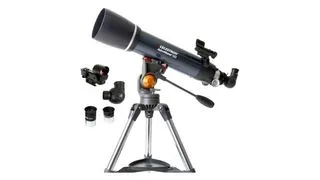 The Celestron AstroMaster 102AZ Refractor with accessories
The Celestron AstroMaster 102AZ Refractor with accessories
Understanding the basic types helps the telescope amateur choose the best design for their needs.
- Refractors: Use lenses to bend light. They are simple to use, require little maintenance, and are great for sharp, high-contrast views of the Moon and planets, though large apertures can be expensive and they can suffer from chromatic aberration.
- Reflectors: Use mirrors to reflect light. They offer the most aperture for your money and are good all-rounders, performing well on both solar system objects and deep-sky targets. They require occasional mirror alignment (collimation) and the open tube can be affected by air currents. Newtonian and Dobsonian designs are common reflector types popular with the
[amateur astronomy telescope](https://lifetodiscover.com/amateur-astronomy-telescope/)community. - Catadioptrics (Compound): Use a combination of lenses and mirrors. They are compact and portable for their aperture and focal length, versatile for different types of observing, and good for astrophotography. They tend to be more expensive than reflectors of the same aperture. Schmidt-Cassegrain and Maksutov-Cassegrain are common examples.
For a telescope amateur, the choice often comes down to balancing performance, budget, portability, and ease of use. A small refractor on an alt-azimuth mount is great for casual lunar/planetary views and ease of use. A moderate reflector (like a Dobsonian) offers more aperture for deep sky at a lower cost but is larger and requires manual pointing. A computerized GoTo scope (reflector or catadioptric) adds convenience for finding objects but increases complexity and price. Consider what you want to see most and where you’ll be doing most of your observing. For a [good backyard telescope], size might be less of an issue than portability for travel.
The Telescope Amateur’s Experience: Beyond the Specs
 Man using a telescope at sunset
Man using a telescope at sunset
Becoming a telescope amateur isn’t just about buying a piece of equipment; it’s about engaging with the sky, learning its rhythms, and connecting with a universe far beyond our everyday experience. It’s about the quiet moments under the stars, the thrill of spotting a distant nebula for the first time, or sharing the view of Saturn’s rings with friends and family.
Think about the experience you want. Do you want a technical challenge, learning to navigate the sky yourself with a star chart and a manual mount? Or do you prefer the convenience of a computerized system that lets you jump straight to viewing objects? Do you dream of capturing stunning images of galaxies (astrophotography), or are you primarily interested in simply seeing the wonders with your own eyes (visual observing)? Your goals will strongly influence the type of telescope amateur setup that’s right for you. Engaging with the [amateur astronomy telescope](https://lifetodiscover.com/amateur-astronomy-telescope/) community online or locally can also provide invaluable advice and shared passion.
How We Test Telescopes for the Amateur
Our reviews are built on hands-on experience. We set up the telescopes, often under real-world night sky conditions, observing the Moon, planets, and various deep-sky objects. We assess not just the technical specifications and optical quality (sharpness, clarity, presence of aberrations) but also the user experience: ease of setup, quality of the mount, effectiveness of included accessories (eyepieces, finderscopes), and the intuitiveness of any computerized controls or accompanying apps.
We consider how suitable each telescope is for different levels of experience, from the absolute beginner to the more seasoned telescope amateur. Portability, durability, and overall value for money are also key factors in our evaluations. Our goal is to provide practical, honest assessments to help you make an informed decision on your journey into astronomical discovery. We draw on the expertise of experienced stargazers and professionals in the field to ensure our insights are accurate and helpful for anyone looking for an [amatuer telescope](https://lifetodiscover.com/amatuer-telescope/).
Telescope Amateur FAQ
Starting out as a telescope amateur can bring up many questions. Here are some common ones:
Q: What’s the best first telescope for a total beginner telescope amateur?
A: There’s no single “best” scope, as it depends on your needs. For ease of use right out of the box, a small refractor on an alt-azimuth mount is often recommended. If you want to see fainter objects like nebulas and galaxies and don’t mind manual tracking and a larger size, a 6-inch or 8-inch Dobsonian reflector offers great value in aperture. If you want the convenience of automated object finding, a computerized (GoTo) telescope is a good choice, though they cost more. Consider portability and where you’ll observe from (backyard, dark-sky sites) when making your choice for a [hobby telescope].
Q: How important is magnification for a telescope amateur?
A: Less important than aperture. Aperture determines how much light is gathered and how much detail you can resolve. While magnification makes objects appear larger, if the image is dim (due to small aperture) or blurry (due to poor optics or turbulent air), higher magnification won’t help and can make the view worse. Focus on aperture first, then choose eyepieces that provide a range of useful magnifications for your scope.
Q: Can a telescope amateur use a telescope in a city with light pollution?
A: Yes, but light pollution significantly impacts views, especially of faint deep-sky objects like galaxies and nebulas. Planets and the Moon are less affected by light pollution as they are very bright. For deep-sky observing in a city, a larger aperture helps gather more light, but traveling to a darker location is the best solution. Some advanced telescopes and filters can help mitigate light pollution effects. A [good backyard telescope] in a city might be better suited for planetary viewing.
Q: What are the essential accessories for a telescope amateur?
A: Beyond the telescope itself and included eyepieces, useful accessories often include:
- Additional eyepieces to provide different magnifications (aim for low, medium, and high power).
- A finderscope if one isn’t included or is of poor quality.
- A sturdy tripod or mount (if not part of the package).
- A red flashlight (to preserve night vision).
- A star chart, planisphere, or astronomy app to help you find your way around the sky.
- Power source (if your telescope has a motorized mount).
Q: Is astrophotography possible for a telescope amateur?
A: Absolutely! While high-end astrophotography setups can be complex and expensive, many modern telescopes designed for amateurs are capable of astrophotography, especially when paired with the right camera (a smartphone, DSLR, or dedicated astro camera) and a sturdy, accurately tracking mount (often an equatorial or a good GoTo alt-azimuth). Some smart telescopes even make capturing deep-sky images relatively simple. Look for telescopes with stable, motorized mounts if astrophotography is a goal. Guides on the [top 10 amatuer telescopes] often highlight models suitable for imaging.
Conclusion
Stepping into the world of astronomy as a telescope amateur is an incredibly rewarding pursuit. It opens your eyes to the beauty and scale of the universe, offering a unique perspective on our place within the cosmos. Finding the right first telescope is a crucial step, but with a little understanding of the basics and clarity on your own interests, you can choose an instrument that will provide countless hours of awe and discovery. Whether you opt for a simple manual scope, a convenient computerized model, or something in between, the journey of exploring the night sky awaits. So set up your scope, look up, and prepare to be amazed – the universe is ready for you to explore.
